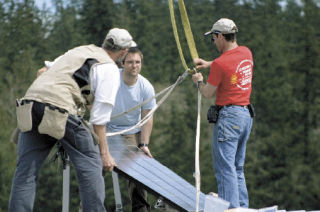When students Dylan Fate and Trevor Martin came up with an idea for their senior culminating project, they asked South Whidbey High School principal Rob Prosch for help.
When Prosch discovered the school would save money if the idea succeeded, they didn’t need to ask twice.
Fate, Martin and 20 other volunteers and students helped install two racks of four panels each of photovoltaic solar cells on top of the bleachers at Waterman Field on Saturday.
The panels are expected to generate up to 200 watts of energy per panel on sunny days, for a total of 1.6 kilowatts. The panels will convert the generated direct current into alternating current for use at the school after being hooked into the school’s power grid.
Fate said savings could reach or exceed $400 dollars per year in incentives — that is, savings on power the school will not have to purchase.
The installation was the conclusion of a two-day solar panel workshop where teachers covered inverter technology, system design, transportation issues, costs and the future of alternative energy.
Teacher and mentor Jay Freund-lich said the project gave students hands-on experience into project management and communications with the adults involved.
“They learned persistence, a quality we try to instill in our students,” Freundlich said.
In years to come, high school students will monitor data in Freundlich’s math class, keeping track of how well the panels are doing under various weather conditions.
On Saturday, following their classroom endeavors, it was time for the real world.
The students had contacted Victor Hanson of Hanson’s Building Supply in Langley.
“They called and needed the panels lifted and I had no problem helping them out,” Hanson said. Driver Larry Stuart also donated his time to the project.
After carefully attaching the lifting rig, the panels were hoisted 90 feet into the air to applause from those watching — including Willie Bays, 6, who seemed to have an uncommon understanding of the process.
“I learned that solar power is good because you can get money for selling electricity to the power company,” Willie explained. “By the way, the panels are 64 volts.”
Though Fate ran the accounting data, he said it isn’t a real money-maker.
“We’re making a statement that South Whidbey is ‘green’ and that the community is aware of the environment,” Fate explained. “Including alternative ways to create power by moving away from fossil fuels.”
The group also has plans for the installation of an electric vehicle charging station sometime in the future.
Martin found that the educational value was worth the effort.
“It was a real learning experience,” he said. “Dylan and
I worked with a lot of people on this project and discovered there was a high level of interest in the community.”



